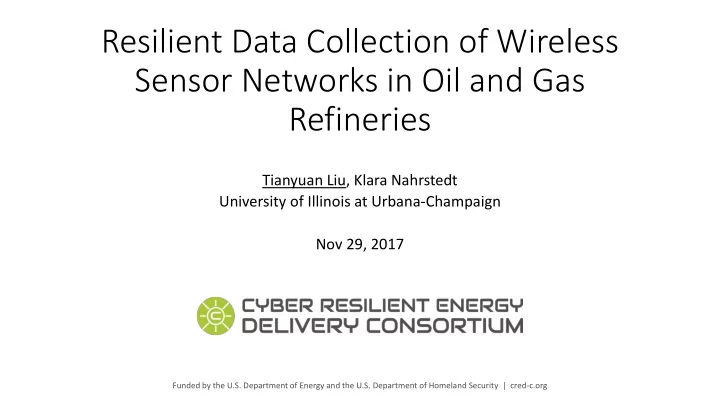

Resilient Data Collection of Wireless Sensor Networks in Oil and Gas Refineries Tianyuan Liu, Klara Nahrstedt University of Illinois at Urbana-Champaign Nov 29, 2017 Funded by the U.S. Department of Energy and the U.S. Department of Homeland Security | cred-c.org
Motivation – Wireless Sensors • Wireless sensing improves refinery operations • Emerson process management suggests a saving of $12.3M/year for a typical 250-Mbpd refinery by deploying wireless sensing technology.
Motivation – Refinery Resiliency • The sensors are deployed in open areas • Subject to cyber-attacks and hazardous environment • Hurricane Harvey destroyed the nation’s largest refinery in August 2017. • Motivates • Fast failure detection • Large-scale failure tolerance • Efficient failure recovery • Minimizing risks for cyber-attacks cred-c.org | 3
Motivation – Defining Resiliency • The resiliency from networking aspect: Ability of the sensor network to maintain connectivity to the data center under large scale failures. cred-c.org | 4
Related Technology – WirelessHART • WirelessHART • A wireless mesh network communication protocol for process automation applications. • Based on the Highway Addressable Remote Transducer Protocol (HART). cred-c.org | 5
Related Technology – WirelessHART • WirelessHART • A wireless mesh network communication protocol for process automation applications. • Based on the Highway Addressable Remote Transducer Protocol (HART). • Failure Tolerating Approach • Disjoint multi-path structure • Tolerates single point of failure - does not tolerate large scale failures cred-c.org | 6
Related Technology – WirelessHART • WirelessHART • A wireless mesh network communication protocol for process automation applications. • Based on the Highway Addressable Remote Transducer Protocol (HART). • Security design • Defense for jamming, eavesdropping, replay attacks, man-in-the-middle attacks, and Sybil attacks • Devices use a shared join key to authenticate themselves to the Gateway - an attacker may have access to the key by compromising a device cred-c.org | 7
Our Approach • Embedding resiliency into data collection framework • Wireless mesh network • Multi-tree structure • Tolerate large scale failures by a distributed self-healing protocol • Reduce the risk of leaking shared join key • Construct optimal data collection paths • Recover connectivity under failures by self-healing cred-c.org | 8
Model • Model: • Sensors send data to master via SCADA-like protocol • Short-range v.s. long-range communication capabilities • Hop-by-hop communication • Fail-stop model cred-c.org | 9
Construct Data Collection Path • Optimization goals: • Minimize data collection time (tree height) • Bound key leakage probability (tree size) cred-c.org | 10
Failure Detection • Every sensor runs failure detection for its parent • Upon parent failure detected, trigger self-healing cred-c.org | 11
Recover Connectivity cred-c.org | 12
Solution Highlights • Construct data collection trees • Centralized planning • Data collection time optimization by Mixed-Integer Linear Programming (MILP) • Shared key leakage probability is bounded • Recover connectivity under failures • Distributed self-healing protocol • Heuristic approach to re-construct backup data collection paths cred-c.org | 13
Experiments • Simulation • Generate topologies with up to 500+ sensors • Inject large scale failures with 2% of nodes • Achieve >90% failure recovery (reliability), with <7% overhead on data collection time (efficiency) • Testbed of Prototype on Raspberry Pi 3 • CPU utilization (< 2%) • End-to-end delay for self-healing protocol (< 5s) cred-c.org | 14
Publication and Software • A paper at CNC workshop 2018, and a technical report. • A planning software which computes the optimal data collection paths. • An extendable testbed for self-healing protocols. (https://github.com/yuralty/SHTestbed) cred-c.org | 15
Future Directions • Explore alternative topologies and placements of sensors for trustworthy sensor networks over the O&G infrastructures. • Explore other resilient monitoring technologies with an emphasis on location-based services, e.g. in drone monitoring systems. cred-c.org | 16
Thank you! Tianyuan Liu and Klara Nahrstedt {tliu60, klara}@illinois.edu cred-c.org | 17
Recommend
More recommend